In recent years, more and more gardeners have begun to plant blackberries on their plots. Despite the fact that this culture is relatively new to us, nurseries offer a large selection of seedlings. There is so much choice that it is easy for an unprepared person to get confused. To prevent this from happening, we will now try to figure out what types of blackberries there are and what is their difference.
On this page, the most promising and popular varieties of this plant are selected, with a description of each variety, photographs and brief planting recommendations.
Depending on the structure of the bush, these plants are conventionally divided into:
- Kumaniki are more like raspberries. The stems of older varieties are prickly, grow upward and require support. They reproduce, like raspberries, by root suckers. The winter hardiness of brambles is high, but most still require shelter for the winter.
- Dewberries are similar to wild blackberries with long creeping shoots. There are varieties with thorny shoots, and others without thorns at all. It is also grown on trellises. Propagated by digging shoots. The yield is higher and the taste of the berries is usually better than that of brambles. Frost resistance is low, it is necessary to cover it for the winter.
Blackberries, like raspberries, have a two-year development cycle: in the first year the shoots grow, lay fruit buds, bear fruit the next year and are cut out after harvesting. Exceptions are remontant blackberry varieties that bear fruit on both young and last year's shoots.
In most of our country, winters can be quite severe and therefore most gardeners are interested in frost-resistant plants. Thornless and remontant blackberry varieties are in great demand. They all have their pros and cons.
Frost-resistant blackberry varieties for the Moscow region and the middle zone
Blackberry variety Agawam
Agawam - an old and very frost-resistant blackberry variety. It is even included in the State Register of varieties recommended for cultivation in the Russian Federation. It can be grown not only in the Moscow region, but also in Siberia.
- Productivity 3 - 6 kg. sometimes up to 10 kg. from one bush
- Weight of berries is 3 - 5 grams, sweet taste, ripen in July - August.
- Fruiting lasts at least 15 years
- Shoots are erect, powerful, rigid with sharp spines, 2.5 - 3 meters high
- Withstands frosts down to -40º, no winter shelter required
Advantages of the variety: beautiful flowering, stable fruiting, no need to cover for the winter, drought-resistant and shade-tolerant, grows on any soil and is generally very unpretentious.
Flaws: The thorny shoots cause a lot of inconvenience and produce a lot of growth.
In the south, Agawams can be grown in both shade and sun. In the northern regions, berries in the shade may not have time to ripen, so planting in the sun is recommended. When planting, the root collar is buried several centimeters. The distance between bushes is 1 meter, between rows 1.8 - 2 meters. Although the shoots are strong, it is better to tie them like a fan to the trellises.
Reviews - very contradictory. There are ardent supporters of this variety, but there are also ardent opponents who complain that Agawam shoots have taken over the entire garden.
Blackberry Polar
Polar - frost-resistant, thornless, early, large-fruited garden blackberry of Polish selection.
- Productivity 5 - 6 kg. berries from each bush (when wintering without shelter)
- The berries are very large, 10 - 12 g, sweet, and in the southern regions they begin to ripen in early July.
- Withstands frosts down to -30º shelter is not necessary. But most gardeners note that if the bushes are covered for the winter, the yield increases several times. It follows from this that the fruit buds still freeze slightly and shelter will be completely unnecessary.
- Stems are erect, up to 2.5 m, strong, without thorns. They may break when bent to the ground. To make the task easier, you need to start tilting the shoots in advance, before they become lignified.
Advantages of the variety: frost resistance, large and tasty berries, thornless shoots, disease resistance, early ripening of the crop, good transportability.
Flaws: perhaps there is only one - it is difficult to bend the shoots to the ground for wintering.
Prefers to grow in full sun, on well-drained loamy soils. Does not like damp, waterlogged places.
Reviews: only positive ones.
Unfortunately, the choice of frost-resistant blackberry varieties is not large. Only Agawam and Polar can overwinter without shelter, but it is better to cover Polar for the winter as well. All other varieties of this plant require mandatory shelter.
New thornless blackberry varieties
Currently, surprisingly productive varieties of brambles and dewberries have appeared on the market. From one bush you can collect 2 - 3 buckets of healthy and tasty berries. The mass of these berries can be so large that buyers at the market refuse to take them, thinking that they are stuffed with all sorts of chemicals. After reading the descriptions of these varieties, you will understand that this is not an exaggeration.
Natchez
Natchez - an early-ripening, very large-fruited, thornless variety of blackberry.
- Productivity up to 20 kg per bush
- The berries are very large, weighing 10 - 12 g. sweet taste, they begin to sing as early as June. Fruiting lasts 35 - 40 days
- Semi-erect bushes, shoots up to three meters long.
- For the winter, covering with agrofibre is required, which is removed only after the soil has thawed and the buds have swollen. If the bush is opened earlier, the shoots may dry out and the plant will die. This rule applies to other varieties of blackberries.
- When planting, maintain a distance of 3 meters between bushes and 2 meters between rows.
Advantages: high yield, large fruit, early ripening, good keeping quality and transportability of berries, extended fruiting period
Flaws: low winter hardiness, small number of replacement shoots.
Reviews: reviews are very good, there was a bit of controversy about the taste of Natchez. The fruits of this blackberry variety have a sweet taste, but there is a slight bitterness in it, some do not like it, others believe that it is the bitterness that gives such a unique and refined taste to these berries, and many did not feel the bitterness at all.
Ouachita
Ouachita - thornless, large-fruited blackberries of early ripening
- The declared yield of this variety reaches 30 kg. from every bush
- Large berries 6 - 7 gr. and with a very original taste, they begin to ripen in June. Fruiting is extended and lasts almost two months.
- The bushes are powerful, erect, shoots grow up to 2.5 - 3 meters. It is grown on a trellis, usually with three rows of wire.
- The plant must be covered for the winter.
- When planting using the bush method, the distance between blackberry seedlings is 1.5 - 2 meters.
Advantages: very long ripening period, amazing yield, disease resistance, berries with an original taste do not lose their commercial qualities for a long time.
Flaws: poor frost resistance -17º, the need to bend rather thick shoots.
The proposed video is in English, but it clearly shows what kind of harvest can be harvested from this plant. By the way, Ouachita, Auchita, Ouachita and Ouachita are the names of the same variety, the description of which you just read.
Reviews positive - the variety is easy to grow, not capricious. Farmers love the combination of high yields and moderately large berries with excellent taste.
Chester
Chester is an old, well-known, thornless, large-fruited, late-ripening blackberry variety.
- The declared yield is 15 - 20 kg. from every bush
- The berries are sweet with a slight sourness, weighing from 5 to 8 grams, ripen in late July or early August.
- The plant has a semi-creeping bush shape. No more than 5 - 6 shoots are left for fruiting, which grow 2 - 3 meters long.
- Despite frost resistance down to -26ºС, shelter is required for the winter period.
- When planting, you must maintain a distance between bushes of 2 - 2.5 meters.
Advantages: high frost resistance, absence of prickly thorns, excellent yield, good transportability of berries, the variety is resistant to major diseases and pests.
Flaws: Despite good frost resistance, winter shelter is required. Does not tolerate shading and planting in damp lowlands.
Reviews: only positive, many consider Chester the best variety in their collection and assign the best places for it.
Black Satin
Black Satin - just like Chester, a rather old variety of thornless garden blackberry, with an average ripening period.
- The average yield is 10 - 15 kg, and with high agricultural technology up to 20 - 25 kg.
- Berries weighing about 5 grams, collected in large clusters. The taste is from sour-sweet to sweet, ripen in mid-late July.
- The bushes are semi-creeping. The stems are tough, up to 5 meters long. It is recommended to immediately press the young shoots to the ground and grow them in an inclined position, then it will be easier to cover them for the winter.
- Frost resistance is 22º C and winter shelter is required in most regions.
- To grow, you will need a trellis about two meters high.
Advantages of the variety: absence of prickly thorns, high yield, unpretentiousness, disease resistance.
Flaws: the need to cover each year for the winter, hard shoots that often break when bent to the ground, poor transportability of berries.
Reviews: generally positive, generous, unpretentious variety, winters well under cover. But the berries ripen quickly, so you can’t be late in picking them. For commercial purposes, not the best option.
Loch Tay
Loch Tay - large-fruited, non-thorny blackberry of medium ripening period.
- The declared yield is 10 - 12 kg. from every bush. Most gardeners claim that this is true.
- The berries are large, weighing about 5 grams. The taste is sweet and sour; they ripen in mid-July.
- Loch Tay has a semi-creeping bush form. The shoots are vigorous, elastic, up to 5 meters long, requiring trellises.
- The frost resistance of this blackberry variety is 20º C. This is not enough for our country; it has to be covered for the winter.
- When planting, the distance between bushes is at least 2 m.
- Propagated by digging in the tops of replacement shoots.
Advantages: good yield, absence of prickly thorns, excellent taste of berries and excellent transportability.
Flaws: the need to cover the plant for wintering every year.
Reviews: According to most gardeners, Loch Tay is one of the best varieties of garden blackberries.
Kiova
Kiova - blackberries with the largest berries. Unfortunately, this variety has sharp thorns, but it is included in the description due to its exceptional large fruit.
- Kiowa's yield exceeds 30 kg. berries from one bush.
- Huge berries weigh 20 - 25 grams. They begin to sing at the end of July.
- The bush is erect, the height of the shoots is 1.6 - 2 meters, they require support.
- This blackberry tolerates frosts down to -23 degrees without loss. Without shelter it can winter only in the southern regions.
Advantages: a very productive variety, surprisingly large and tasty berries, good transportability, the ability to surprise neighbors.
Flaws: the presence of sharp thorns, the need to cover the bushes annually for the winter.
All reviews something like this: when I cover the bushes for the winter, I swear that this is the last time I will suffer with these thorns, and when I start harvesting, I understand that these blackberries will always grow for me.
Columbia Star
Columbia Star - a new, little-known, thornless variety of early ripening blackberries.
- According to the manufacturer, Columbia Star will be one of the most productive varieties (16,750 kg/ha)
- The berries are the same size, elongated, weighing 10 - 15 grams, begin to ripen in late June - early July.
- Creeping bushes, shoots 4 - 5 meters long, without thorns.
- Winter hardiness of Columbia is low - 14 degrees, winter shelter is required.
Advantages: tasty, large berries retain their marketable appearance for a long time, high yield, fairly soft and thornless shoots, easy to press to the ground for winter shelter. The variety easily tolerates heat and drought.
Flaws: long shoots with many lateral shoots can be difficult to untangle when removed from the support.
Reviews: gardeners who managed to plant Columbia have not yet been able to fully appreciate this variety, but everyone notes the high taste of the berries. Many consider it the most promising new product.
Chačanska Bestrna
Chačanska Bestrna - a high-yielding, thornless variety of early ripening blackberries.
- Productivity 12 - 15 kg. berries from one bush.
- The berries are sweet and sour, weighing 9-14 grams, and begin to ripen in early July.
- The bushes are semi-creeping, the shoots are powerful without thorns, they grow up to 3 - 3.5 meters. Requires tie-down to supports.
- The frost resistance of the variety is relatively high -26º, but it still needs to be covered.
Advantages: high yield, drought resistance, unpretentiousness, immunity to major diseases.
Flaws: poor transportability, ripe berries begin to leak within a day or two. True, for amateur gardening this drawback is not very important.
Reviews: all reviews are good, this variety has proven itself well in both the southern and northern regions.
Doyle
Doyle - one of the best varieties of thornless blackberries. It claims to be the most productive variety.
- Doyle's documented yield is 5 - 7 buckets of berries from one bush.
- The berries are sweet and sour, weighing 7 - 9 g. Ripening later - mid-August.
- The bushes are semi-erect with long shoots up to 5 - 6 m, no thorns. Trellis are required for growing
- It needs to be covered for the winter.
Advantages: amazing yield, easily tolerates heat and drought.
Flaws: This blackberry is more suitable for the southern regions; in the northern regions it may not have time to ripen.
Reviews: There are very few reviews; in Russia this variety has only been cultivated for a few years.
Waldo
Waldo - an old and proven, thornless, creeping blackberry variety of medium-early ripening.
- The authors of the variety promise a yield of 15 - 17 kg. berries from one bush.
- Berries weighing 6 - 8 grams. They have a pleasant taste and aroma and begin to sing in the first ten days of July.
- Bushes creeping, compact. The length of the shoots does not exceed 2 meters, but support is needed.
- Winter hardiness is average; winter shelter is a must for this blackberry.
Advantages: no thorns, easy to cover for the winter, ideal for small areas.
Flaws: In hot weather, berries may bake.
Loch Ness 'Loch Ness'
Loch Ness - thornless, very productive blackberry, medium-late ripening.
- The yield of this variety can reach 25 kg. from every bush.
- The berries are sweet, with sourness, similar to the taste of wild blackberries 5 - 8 g. They begin to ripen at the end of July.
- The bushes at Loch Ness are vigorous and semi-creeping. Stems up to 4 meters long require support.
- Winter hardiness for our climate is not high enough; the bushes have to be covered in winter.
- When planting, the distance between bushes is at least 2 meters.
Advantages: consistently high productivity, unpretentious in care, quickly and easily propagated, suitable for commercial use.
Flaws: ripens late, in rainy summers the taste becomes sour.
Reviews: definitely good - with minimal care there is always an excellent harvest.
Oregon Thornless
Oregon Thornless - thornless, creeping blackberry of late ripening.
- The yield is average, about 10 kg. berries from each bush.
- The berries are sweet and sour, large, weighing 7-9 grams, ripen in August.
- The plant forms creeping bushes, with thornless shoots up to 4 meters long. Trellis are required for cultivation.
- Oregon can withstand temperatures dropping to -29 degrees, which is clearly not enough for the middle zone and you can’t do without shelter.
Advantages of the variety: excellent taste, absence of prickly thorns, easy to cover for the winter, the decorative nature of the plant allows it to be used for decorating gazebos, arches and other buildings.
Reviews: “I have this variety among my favorites - the most problem-free - it winters well (under cover), replacement shoots appear immediately, almost simultaneously with the beginning of the growth of fruit shoots, the size of the berries with sufficient watering is really large, sweet taste, very fruitful."
Osage
Osage - thornless blackberry with ideal taste. This variety is considered the most delicious of all blackberry varieties.
- The yield is relatively low - 3 kg. berries from each bush.
- Berries with a perfectly balanced taste and weight 6 - 7 g. They begin to sing in the first ten days of July.
- The bushes are erect, shoots without thorns, about 2 meters high.
- Frost resistance is low, only -13º, shelter is required.
Advantages: exquisite, dessert taste, the sweetest of all blackberry varieties, never sets your teeth on edge.
Flaws: low winter hardiness and relatively low productivity.
Description of remontant blackberry varieties
Remontant blackberry varieties can be grown for one harvest or two. In the first case, all the shoots are cut out at the roots in the fall and a completely empty bed is left in the winter. In the spring, young shoots begin to grow from the roots; berries begin to ripen on them at the end of August.
To get two full-fledged harvests next year, only last year's shoots are cut out in the fall, and the young ones are bent to the ground, covered and allowed to go into winter. In June of next year, the berries begin to sing on these shoots. At the end of July, after the entire harvest has been harvested, these shoots are cut out.And already at the end of August, the young shoots that have grown over the summer begin to bear fruit. This way you can enjoy blackberries almost the entire summer season.
Unfortunately, all this pleasure is available only to residents of the southern regions. In the northern regions, remontant blackberry varieties do not justify themselves. It is not uncommon for some of the berries to die from frost. The first crop (partially or completely) may die during the flowering stage from return frosts. The second one will begin to sing only at the end of August, or even at the beginning of September. The berries simply do not have time to ripen and part of the harvest goes under the snow.
Freedom
Prime-Ark Freedom - a thornless, remontant variety of blackberry.
- The authors of the variety promise high yields. The variety is new and there are no exact figures yet.
- The berries are sweet, large, weighing 15 - 20 grams; the first harvest begins to ripen in mid-June, and the second in the third decade of August.
- The bushes are erect, medium-sized, thornless stems about 2 meters high.
- Shelter is required for the winter.
- Propagated by root shoots and cuttings.
Advantages: high productivity, excellent fruit quality and excellent taste, the ability to receive products throughout the summer.
Flaws: low winter hardiness, the variety is recommended only for the southern regions, the need to bend and cover the shoots for the winter.
Black Magic (Black Magic)
Black Magic (Black Magic) - remontant blackberry variety (stems with thorns)
- Productivity from 5 kg. from one bush.
- The berries are sweet, weighing on average 7 - 10 grams. Ripening dates are the end of June for the first harvest and the last ten days of August for the second harvest.
- The shoots are strong, about 1.5 meters high, with relatively few thorns.
- Winter hardiness is weak -12º, winter shelter is required.
Advantages: This variety is best adapted to the climatic conditions of our country than all the rems. Excellent fruit quality, high productivity, tolerates heat and drought well.
Flaws: thorny shoots, low frost resistance, strong shoots are difficult to press to the ground.
Reuben
Reuben - remontant, large-fruited variety of garden blackberry (with thorns)
- Productivity from 6 kg. from one bush.
- The fruits are sweet, large, average weight about 10 grams. Ripen at the end of June and end of August.
- The shoots are erect, medium-sized with thorns.
- The plant can withstand temperatures down to -16º; shelter is required.
Advantages: the variety is resistant to frost, tolerates shading well, and has excellent transportability of berries.
Flaws: the main disadvantage is the sterilization of pollen already at +30º
Prime-Ark 45
Prime-Ark 45 - a new remontant variety of blackberry (with thorns).
- Manufacturers promise good yields, but there is no concrete data yet.
- The berries are transportable, sweet in taste and weighing 6 - 8 grams.
- The bushes are erect, with a moderate number of thorns. They tolerate heat and drought well.
- It does not overwinter without shelter.
Traveler – Prime-Ark Traveler
Traveler – Prime-Ark Traveler - new, thornless remontant blackberry.
- This variety has not yet been studied much, but the Americans claim that productivity will be at its best.
- The weight of the berries is 7 - 8 g. The taste is sweet and sour.
- Erect bushes, about two meters high, without thorns
- When grown for two crops, the shoots bend to the ground in the fall and are covered with spunbond in 2 - 3 layers.
Don't forget to read:
Technology for planting and caring for garden blackberries here ⇒
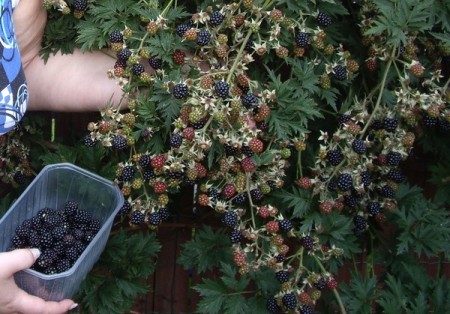
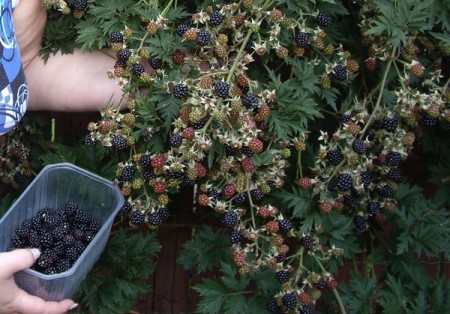
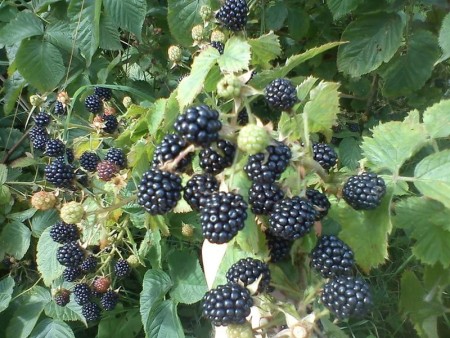

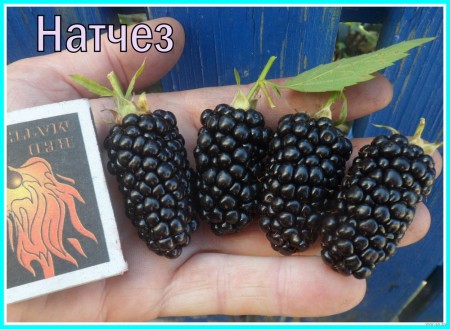

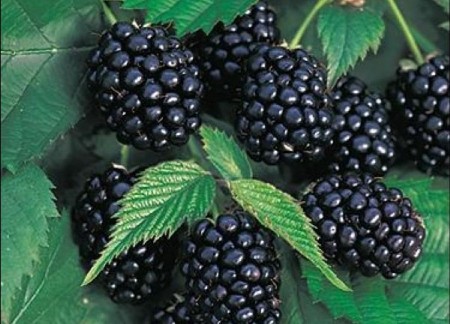
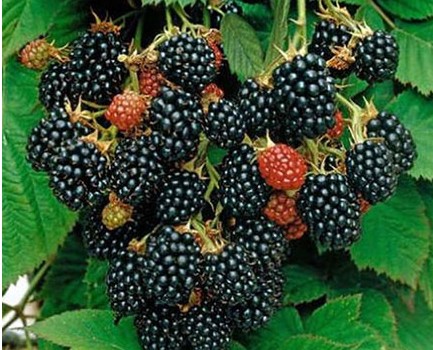
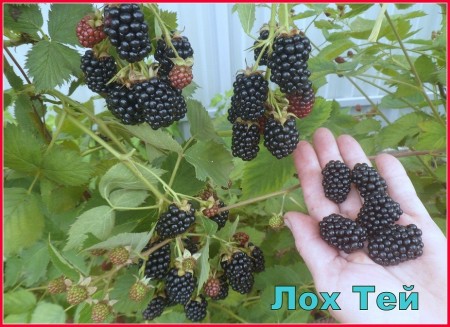
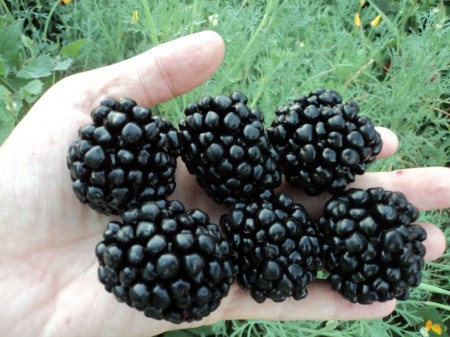
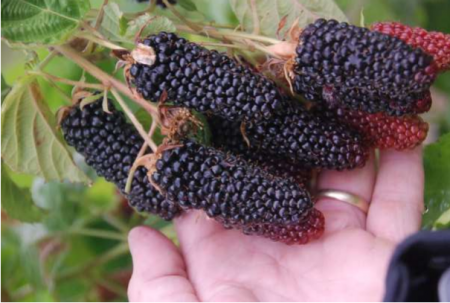
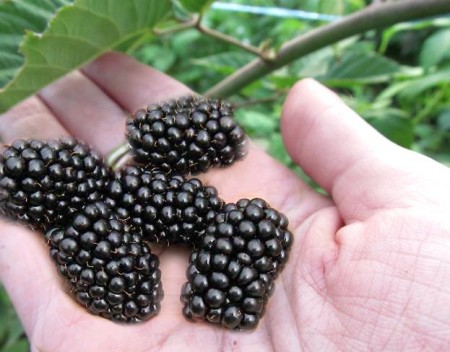
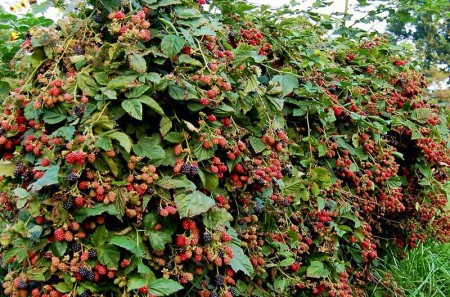
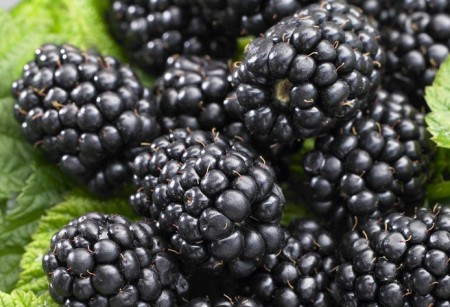
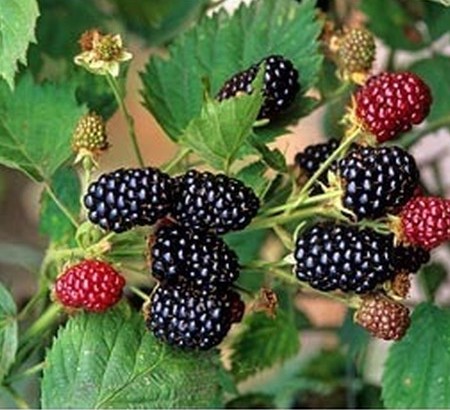
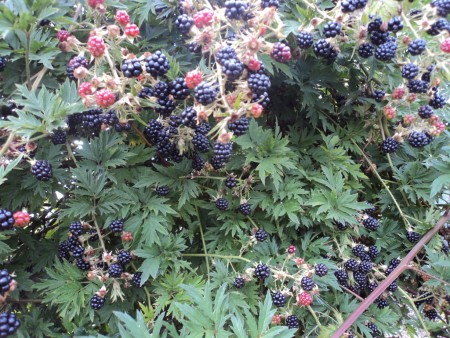


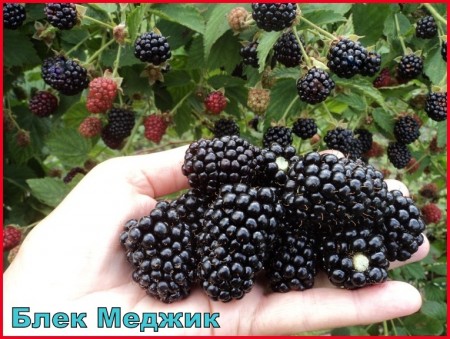
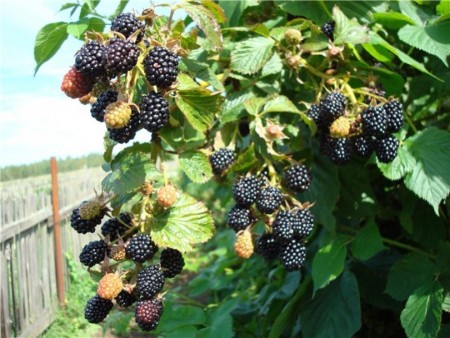
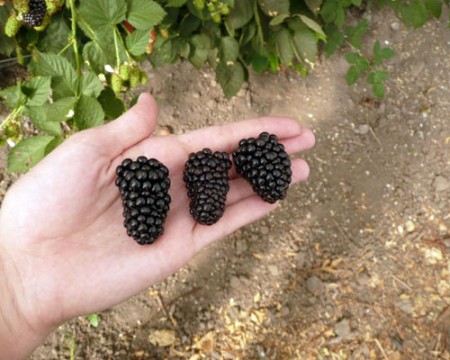
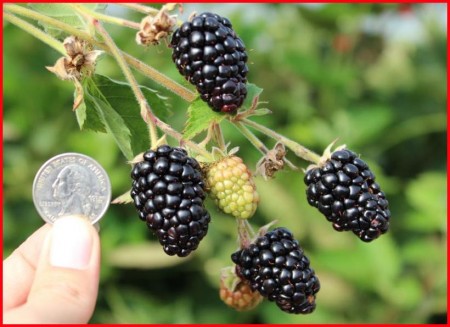

 (36 ratings, average: 4,36 out of 5)
(36 ratings, average: 4,36 out of 5) CUCUMBERS NEVER GET SICK, I'VE BEEN USING ONLY THIS FOR 40 YEARS! I SHARE A SECRET WITH YOU, CUCUMBERS ARE LIKE THE PICTURE!
CUCUMBERS NEVER GET SICK, I'VE BEEN USING ONLY THIS FOR 40 YEARS! I SHARE A SECRET WITH YOU, CUCUMBERS ARE LIKE THE PICTURE! You can dig a bucket of potatoes from each bush. Do you think these are fairy tales? Watch the video
You can dig a bucket of potatoes from each bush. Do you think these are fairy tales? Watch the video
 How our fellow gardeners work in Korea. There is a lot to learn and just fun to watch.
How our fellow gardeners work in Korea. There is a lot to learn and just fun to watch. Eye trainer. The author claims that with daily viewing, vision is restored. They don't charge money for views.
Eye trainer. The author claims that with daily viewing, vision is restored. They don't charge money for views. A 3-ingredient cake recipe in 30 minutes is better than Napoleon. Simple and very tasty.
A 3-ingredient cake recipe in 30 minutes is better than Napoleon. Simple and very tasty. Therapeutic exercises for cervical osteochondrosis. A complete set of exercises.
Therapeutic exercises for cervical osteochondrosis. A complete set of exercises. Which indoor plants match your zodiac sign?
Which indoor plants match your zodiac sign? What about them? Excursion to German dachas.
What about them? Excursion to German dachas.
The video showing Loch Ness is not Loch Ness at all
But it seems to me that Loch Ness is, I won’t argue, but it’s similar.
I've been growing Chester for a long time, it's a good variety and I'm very pleased with it. True, I live in the Rostov region, although to the north it may not have proven itself so well.
I advise everyone to take the choice of variety seriously. I have had a Navajo bush for 3 years now and every year the same thing freezes and grows, freezes and grows. I've been meaning to dig it up and throw it away for a long time, but it's a PITY.
Where do you live, Raisa?
Sorry, I should have written right away - Leningrad region.
Last year, the young bush bloomed well and there was a lot of ovary, but the berries did not have time to ripen. For unknown reasons, all the blackberries withered and fell off. I'm afraid the same thing will happen again this year. Has anyone encountered this problem, what could be the problem?
Do thornless blackberries really have no thorns or are there just few of them?
Victor, if the bush is young and bears fruit for the first time, then most likely it was simply overloaded. The root system is still too weak and unable to bear all the berries, which is why they fell off.
In order not to overload young blackberry bushes, you need to trim the shoots for the first year or two, leaving no more than a meter. Dmitry, thornless varieties have no thorns at all.